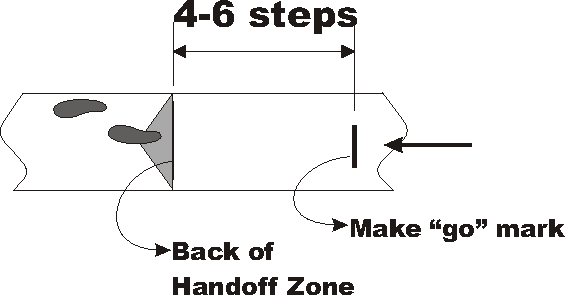
| There are many ways to work that baton around the track, but some work better than
others .. and some don’t work at all when you are working with grade school
children. This procedure is a good one since it is easy for the kids to
understand the basic concepts, and it works in practice as well as theory.
When I was coaching, we would start working on handoffs the very first practice and didn’t stop until the season was over … For some reason, kids
love relays and don’t mind practicing them since it’s less competitive and seemingly easier than individual time trials or conditioning drills. All work
and no play at practice can deplete the roster pretty quickly.. The basic concepts are: (1) the baton always moves Right Hand, Left Hand, Right Hand, Left Hand (2) the baton is always moving down the center of the lane (3) the baton stays in the same hand it was received in; no switching (4) runners on the curve run the inside of the curve; the backstretch and anchor runners stay to the outside of their lanes. The sketch below shows the three handoff points. |


Relay Fundamentals - The ZoneThe sketch below shows the basic configuration of the handoff area which is comprised of an acceleration zone and a handoff zone. In general, except possibly for your #1 Senior Boys relay team, you can ignore the acceleration zone in grade school track. Rules mandate that the handoff must take place in the 20 meter handoff zone, but the League will not disqualify a team for non-compliance .. I’ve seen instances where the waiting #2 runner took off so soon, that they were half way down the backstretch before the incoming runner finally caught up .. no advantage gained usually. All runners should know the rules, however. |


Relay Fundamentals - Getting ReadyAll runners except the Leadoff should make a “Go” mark; I used to have Juniors walk back 4 steps and Seniors 5-6 steps from the back of the Passing Zone to make a visible mark in their lane. At Mater Dei it was easy since it was a cinder track; modern tracks may require a little innovation. This is the “Go” mark. The waiting runners then line up at the back of the handoff zone at the inside or outside of the lane as appropriate (explained later).
|


Relay Fundamentals - The Handoff Rules
The waiting runner watches the incoming runner approach; when the incoming runner reaches the “Go” mark, the waiting runner turns and begins to run at about 75-80% speed looking straight down the track .. Very Important - NO PEEKING .. If the receiver is looking at the handoff, they are grabbing at the baton while the incoming runner is poking .. and they never grab and poke at the same spot. The receiving runner holds their hand straight behind them at hip level with the palm facing up and the thumb facing in .. Give the incomer a nice steady “target” and don’t peek .. The receiver just waits until they feel the baton in their hand and then accelerates to top speed
|

Relay Fundamentals - Handoff Details1st Handoff
|

|
2nd Handoff
|

| 3rd Handoff The Number 3 Runner has the baton in the right hand and runs the inside of the lane around the far curve. The Number 4 (Anchor) is positioned as shown in the sketch and watching the incoming runner come around the bend .. The left arm is extended and when the incoming runner hits the “Go” mark, the receiver turns and straight to the finish .. The baton stays in the left hand since moving it is a distraction. As the Anchor Runner runs through the tape, they throw their arms up in jubilation!! Just make sure, win or lose, they don’t throw the baton .. That’s another cause for disqualification. |


How to Teach the HandoffStart with a demonstration; gather up a group and explain the track setup and the relay zone configuration. Go over the basics
(RH-LH-RH-LH, etc.as discussed on the 1st page). Follow up with an on-the-track handoff demo using two people who are familiar with the process (one of them can be you). Show the group where to stand in the lane - stand to right side; left arm is extended and vice-versa; and how to make a “Go” mark. Show what happens if the receiver leaves too soon or too late - stress the No-Peek concept with the futility of poking and grabbing.
|
